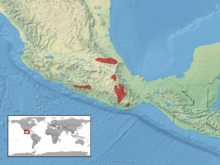Crotalus intermedius (common name Mexican small-headed rattlesnake[3]) is a pit viper species found in central and southern Mexico. Like all other pit vipers, it is venomous. Three subspecies are currently recognized, including the nominate subspecies described here.[4]
| Crotalus intermedius | |
|---|---|

| |
| A Mexican small-headed rattlesnake rests on rocks | |
| Scientific classification | |
| Domain: | Eukaryota |
| Kingdom: | Animalia |
| Phylum: | Chordata |
| Class: | Reptilia |
| Order: | Squamata |
| Suborder: | Serpentes |
| Family: | Viperidae |
| Genus: | Crotalus |
| Species: | C. intermedius
|
| Binomial name | |
| Crotalus intermedius Troschel, 1865
| |

| |
| Synonyms | |
Description
editThis species grows to lengths of 50 to 60 cm (20 to 24 in). Males are somewhat larger than females. Klauber (1972) gives a maximum length of 57 cm (22 in), although captive specimens may grow larger.[3]
Distribution and habitat
editThis snake is found in central and southern Mexico, more specifically in southeastern Hidalgo, southern Tlaxcala, northeastern and south-central Puebla, west-central Veracruz, Oaxaca (in the Sierra Juárez, Cerro San Filipe and the surrounding mountains, Sierra de Cuatro Venados, Sierra Madre del Sur, and the Sierra de Mihuatlán), and in Guerrero (in the Sierra Madre del Sur, west of Chilpancingo). A type locality was not given in the original paper, but "Mexico" is inferred from the title.[2] Smith and Taylor (1950) restricted it to "El Limón, Totalco, Veracruz, Mexico".[3]
Much of the range of this species consists of seasonally dry pine-oak forest, but it has also been found in cloud forest near Omilteme in Guerrero, as well as in the desert near Cacaloapan in Puebla, and Pachuca in Hidalgo.[1][3] It is found at elevations between 2,000 and 3,200 m.[2]
Conservation status
editThis species is classified as Least Concern on the IUCN Red List (v3.1, 2001).[1] Species are listed as such due to their wide distribution, presumed large population, or because they are unlikely to be declining fast enough to qualify for listing in a more threatened category. The population trend was stable when assessed in 2007.[5]
Subspecies
edit| Subspecies[4] | Taxon author[4] | Common name[6] | Geographic range[3] |
|---|---|---|---|
| C. i. intermedius | Troschel, 1865 | Totalcan small-headed rattlesnake | Mexico, in southeastern Hidalgo, northeastern Puebla, west-central Veracruz, and southwestern Tlaxcala, type locality: "El Limón, Totalco, Veracruz, Mexico" |
| C. i. gloydi | Taylor, 1941 | Oaxacan small-headed rattlesnake | South, central, and northern Oaxaca, and central Puebla, type locality: "Cero San Filipe (elevation 10,000 ft) near [15 km northwest of] Oaxaca, Oaxaca, Mexico" |
| C. i. omiltemanus | Günther, 1895 | Omilteman small-headed rattlesnake | Guerrero, several areas west of Chilpancingo, type locality: "Mexico, Omilteme in Guerrero" |
References
edit- ^ a b c Canseco-Márquez, L.; Campbell, J.A.; Ponce-Campos, P.; Muñoz-Alonso, A.; García Aguayo, A. (2007). "Crotalus intermedius". The IUCN Red List of Threatened Species. 2007. IUCN: e.T64319A12766370. doi:10.2305/IUCN.UK.2007.RLTS.T64319A12766370.en. Retrieved 14 January 2018.
- ^ a b c McDiarmid RW, Campbell JA, Touré T. 1999. Snake Species of the World: A Taxonomic and Geographic Reference, vol. 1. Herpetologists' League. 511 pp. ISBN 1-893777-00-6 (series). ISBN 1-893777-01-4 (volume).
- ^ a b c d e Campbell JA, Lamar WW. 2004. The Venomous Reptiles of the Western Hemisphere. Comstock Publishing Associates, Ithaca and London. 870 pp. 1500 plates. ISBN 0-8014-4141-2.
- ^ a b c "Crotalus intermedius". Integrated Taxonomic Information System. Retrieved 9 July 2007.
- ^ 2001 Categories & Criteria (version 3.1) at the IUCN Red List. Accessed 13 September 2007.
- ^ Klauber LM. 1997. Rattlesnakes: Their Habitats, Life Histories, and Influence on Mankind. Second Edition. First published in 1956, 1972. University of California Press, Berkeley. ISBN 0-520-21056-5.
Further reading
edit- Troschel, F.H. 1865. in Müller, Johann Wilhelm. 1865. Reisen in den Vereinigten Staaten, Canada und Mexiko. III. Beiträge zur Geschichte, Statistik und Zoologie von Mexiko. Dritte Abtheilung. Die Wirbelthiere Mexikos. III. Amphibia. Brockhaus. Leipzig. xiv + 643 pp.
External links
edit- Crotalus intermedius at the Reptarium.cz Reptile Database. Accessed 12 December 2007.
